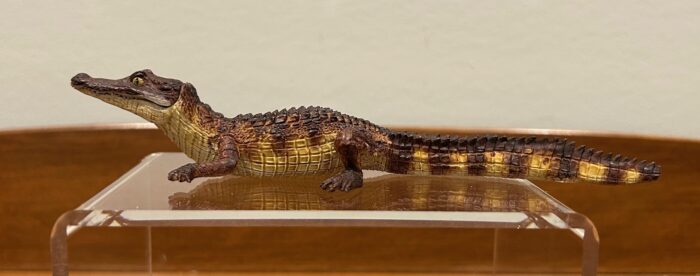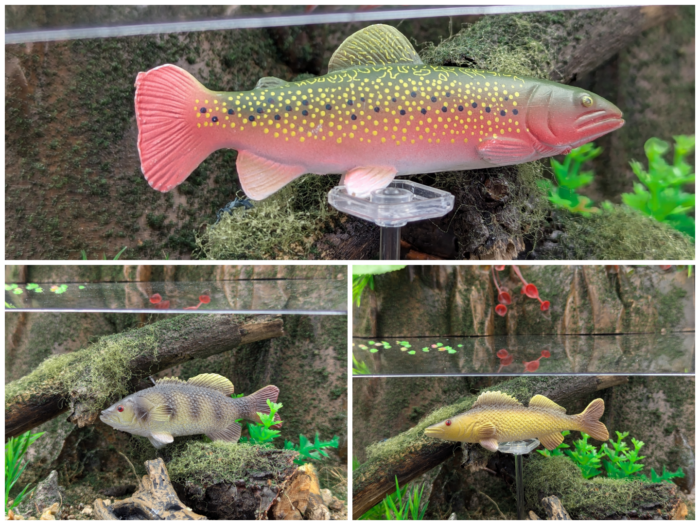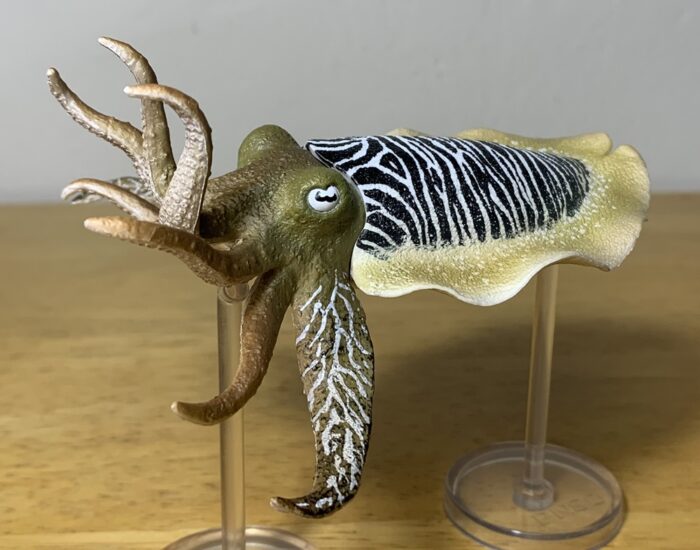The world’s largest and most visually striking dolphin, one of its most intelligent animals, and undisputedly one of its most accomplished predators, the killer whale (Orcinus orca) needs no introduction from me. Whether they’re attacking boats or wearing dead salmon as hats the orca is constantly generating interest and is one of our most beloved and familiar animals.
Caiman (Wild Animals by Papo)

Review and images by Suspsy; edited by bmathison1972
Caimans are members of the alligator family that reside in Central and South America. There are presently six living species ranging in size from the 1.4 metre-long Cuvier’s dwarf caiman, which is the smallest living crocodilian, to the 5 metre-long black caiman, which is the largest member of Alligatoridae.
Smallmouth Bass, Brook Trout, Walleye (3 Inch Northwoods Fish Set Part 1 by Replica Toy Fish)

I’m back with another look at some Replica Toy Fish models. Last time was the 6″ channel catfish figure, this time I’ll be looking at one of the initial sets of three inch figures. There were two sets of six, but I will split them into two posts of three figures just to keep them a little shorter!
British Shorthair, 2024 (Farm World by Schleich)
Pilot Whale (Wild Safari Sealife by Safari Ltd.)

Pilot whales are members of the Delphinidae family that get their name from the unproven belief that a single member of the pod leads the rest and that they’ll follow that individual even if it means certain death, which is supposed to explain why pilot whales strand en mass. Indeed, pilot whales are among the most likely cetacean species to become stranded.
Giant Anteater (Wild Rush 02 by Kaiyodo)

Review and images by Sam; edited by bmathison1972
The giant anteater (Myrmecophaga tridactyla) is an animal of unusual proportions. These insectivorous mammals are native to the tropical rainforests and grasslands of Central and South America, and in Brazil, they are known as tamanduá-bandeira, which translates to “flag anteater,” a reference to their big, fanlike tail.
Wildcat (Large Woodland Animals by Bullyland)

Before I start this review, I must thank the folks at Happy Hen Toys for yet another review sample! It’s been a pleasure working with them in recent years and their generosity is very much appreciated.
Phylogenetics is the study of the evolutionary history of life on Earth, and one of my favorite disciplines of Zoology.
White-tailed Deer, Buck 2012 (Wild Safari North American Wildlife by Safari Ltd.)

In May 2016 the President of the United States signed the National Bison Legacy Act, making the North American bison the official National Mammal of the United States. I think they made the wrong choice and should have gone with the white-tailed deer (Odocoileus virginianus) instead. Hear me out.
Pig Family Playset (Toymany)

Before I start this review, I must again thank @Kenc and the folks at Toymany for gifting me this set as a review sample for the Blog!
The set we are looking at today consists of eight figures of domestic pigs. There are four sculpts: 1) sow, standing; 2) boar, sitting; 3) piglet, resting; and 4) piglet, standing.
Channel Catfish (6 Inch Series by Replica Toy Fish)

I guess it’s been too long since a fish review…or maybe I just realized it would be good to start reviewing the long-lost series of figures from Replica Toy Fish (RTF). For those not aware, this was a company that existed from around 2010 to 2017 or so. In that time, several wonderful fish models were made, focused almost exclusively on freshwater North American species, primarily ones familiar to anglers (that was the originally conceived target market…don’t get me started).
Common Cuttlefish (Sealife by CollectA)

Before we begin the review, I would like to extend my gratitude towards Happy Hen Toys for sending this figure along as a review sample. Happy Hen Toys is a U.S. distributor of animal figures and one of the only places in the country where you can get CollectA figures at a reasonable price.
Announcing… the Monster Toy Blog!

We’ve launched a new partner website, the Monster Toy Blog!
The Monster Toy Blog completes a Holy Toy-rinity of figure review sites together with our existing Animal Toy Blog and Dinosaur Toy Blog sites.
Screenshot of the Monster Toy Blog
We have a dedicated team of eight enthusiastic reviewers – EmperorDinobot, Faelrin, Gwangi, Saarlooswolfhound, SBell, Suspsy, Torvosaurus, and myself – who have been posting plenty of new reviews to launch the site with a monstrous bang.
Visit it now, bookmark it, and subscribe for updates! https://monstertoyblog.com





